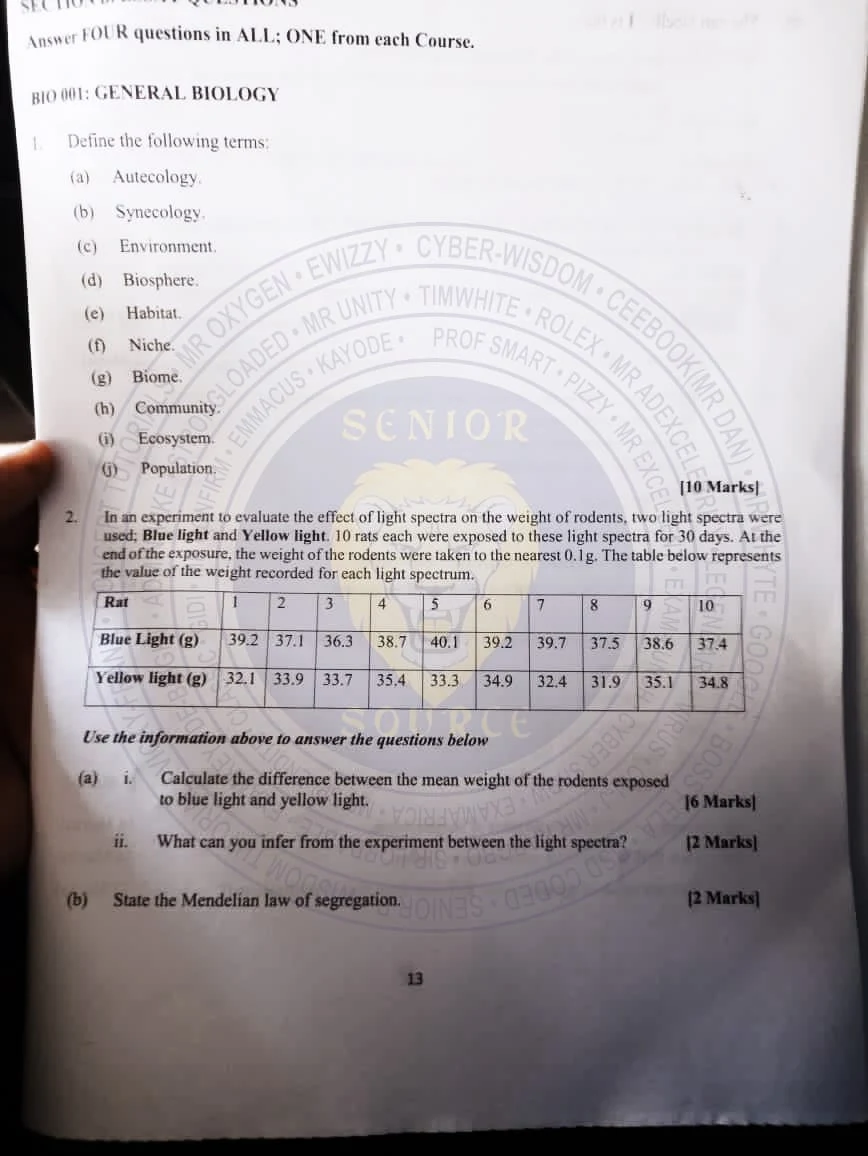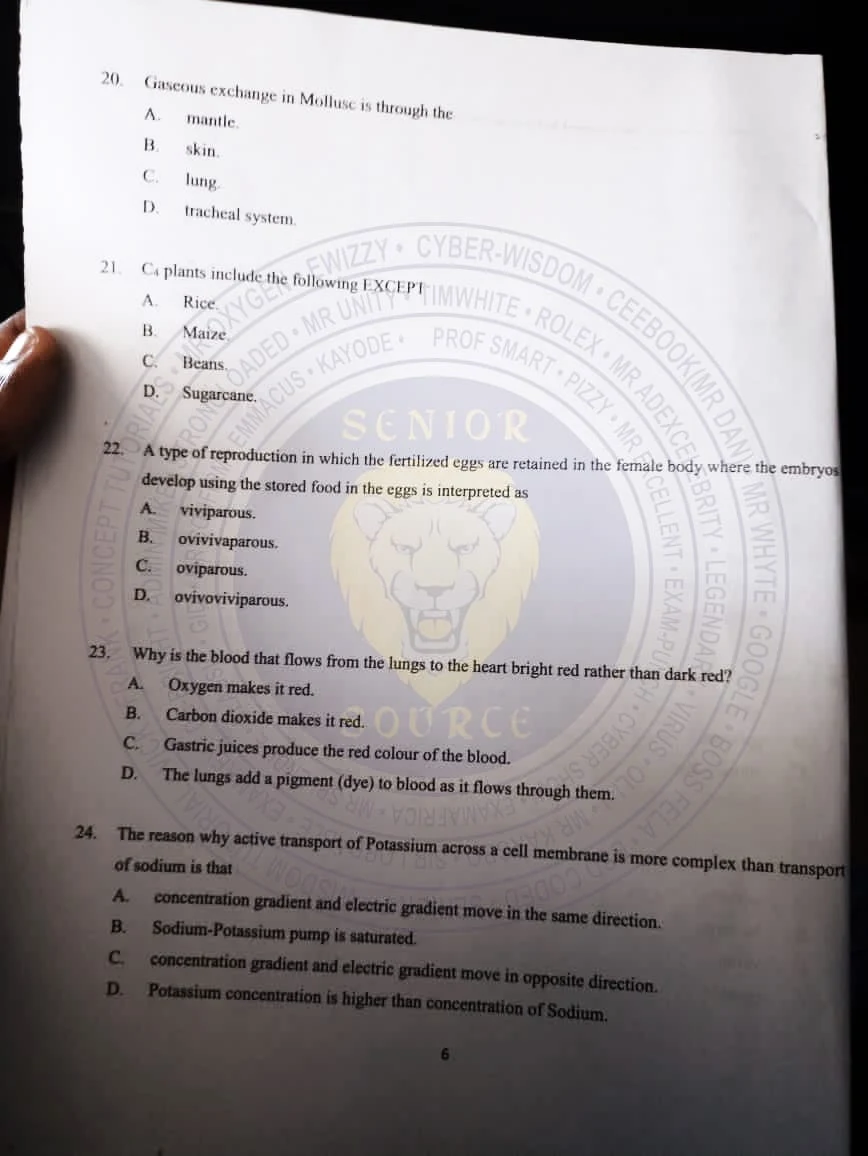Joint Universities Preliminary Examination Board (JUPEB) has scheduled JUPEB Biology 2024 Questions And Answers to Kick off on Tuesday 1st – August – 2024.
JUPEB Biology 2024 Questions And Answers
Here on zamgist, we have solved all the questions for JUPEB Biology 2024 and its available now.

CLICK HERE TO CHAT ME UP ON WHATSAPP & GET IT NOW
| 2024 JUPEB EXPO | JUPEB Biology 2024 Questions And Answers |
|---|---|
| N5000 Naira | |
| Online Password | N5000 Naira |
| Direct SMS | N/A |
| Delivery Time | Midnight or 4 hours before exam |
| Answer page | https://zamgist.com.ng/answer-page |
| WhatsApp No. | 08023429251 |
| Source | ZAMGIST |
| Group | ZAMGIST MIRACLE CENTER |
| WhatsApp Group Link | Click Here to Join |
| Tags | JUPEB Biology 2023 Questions And Answers |
JUPEB Biology 2024 Questions And Answers
==> Online PIN: N5000
Online PIN MEANS The Pin to access our answers online via https://zamgist.com.ng/answer-page will be sent to u at least 4 hours before the exam to access our answers.
==> WhatsApp: N5000
Whatsapp MEANS The answer will be sent to you on WhatsApp after we confirm your subscription. Add Us In WhatsApp With 08023429251.
To Make Payment
Chat 08023429251 on WhatsApp
After Payment, Send The Following details:-
(i) Payment Receipt
(ii) Your Name
(iii) Subject
(iv) Phone number
===> 08023429251 via WhatsApp
RELATED POST:
2024 JUPEB timetable And Exam Starting Date
2024 NECO Biology practical Questions and Answers Expo
2024 NECO Biology practical Questions and Answers Expo
2024 NECO History Questions and Answers Expo
Neco Biology Practical Specimen 2024
2024 NECO Data processing practical Questions and Answers Expo
NECO Biology Specimen 2024: Apparatus and Instructions
NECO Timetable 2023 For Art Student
NECO 2024 Timetable for Science students
NOTE:- All WhatsApp Messages Sent To The Above Number Are Attended To. Always Send Us WhatsApp Message Of Your Complaint, Your Message(s) Will Get To Us And We Will Reply Immediately.
JUPEB Biology Past Questions 2023








JUPEB Biology Answer 2023
JUPEB BIOLOGY
01-10: DBACDCCDDB
11-20: CCBABDDCCA
21-30: CBCCBAABCA
31-40: CDCBDCABCB
41-50: DCCCCAABDC
COMPLETED
=================================
Q1


Q2

=================
JUPEB BIOLOGY
INTRODUCTORY ZEOLOGY
(7a)
Respiration is a biological process that occurs in living organisms to obtain energy from organic molecules, typically glucose. It involves the exchange of gases, mainly oxygen and carbon dioxide, between the organism and its environment. There are two types of respiration: aerobic (with oxygen) and anaerobic (without oxygen).
(7b)
(PICK ANY TWO)
(i)Both processes involve the breakdown of organic molecules, such as glucose, to produce energy in the form of ATP (adenosine triphosphate).
(ii)Both types of respiration start with the process of glycolysis, which is the initial step in the breakdown of glucose into smaller molecules.
(iii)Both aerobic and anaerobic respiration occur in living cells as a means to generate energy for various cellular activities.
(7c)
Mechanism of inspiration in man, During inspiration, the diaphragm and external intercostal muscles contract. The diaphragm moves downwards, and the external intercostal muscles lift the ribcage upward and outward. These actions increase the volume of the thoracic cavity, leading to a decrease in air pressure inside the lungs. As a result, air rushes into the lungs from the surrounding atmosphere, filling the lung’s air sacs (alveoli) with oxygen.
This process enables oxygen to be delivered to the bloodstream for distribution to body tissues and removes carbon dioxide during exhalation
============
(8ai)
Balanced diet refers to a way of eating that provides all the essential nutrients, vitamins, minerals, and energy needed for proper growth, maintenance, and overall health of an individual. A balanced diet typically includes a variety of foods from different food groups in appropriate proportions.
(8aii)
(i)Carbohydrates
(ii)Proteins
(iii)Fats and Oils
(iv)Vitamins and Minerals
(8b)
(PICK ANY THREE)
(i)Bile aids in the digestion and absorption of dietary fats. It emulsifies fats, breaking them down into smaller droplets, which increases their surface area for efficient enzymatic digestion by lipases.
(ii)Bile helps solubilize fat molecules and allows the absorption of fat-soluble vitamins (A, D, E, and K) and other lipids in the small intestine.
(iii)Bile acts as a waste product carrier, transporting waste materials, including bilirubin (a breakdown product of old red blood cells), out of the body through the intestines.
(iv)Bile contains bicarbonate ions, which help neutralize the acidic chyme (partially digested food) that enters the small intestine from the stomach, creating a less acidic environment for digestive enzymes to work optimally.
(8ci)
Erepsin: Erepsin is an enzyme found in the small intestine that helps in the final breakdown of peptides (short chains of amino acids) into individual amino acids.
(8cii)
Maltase: Maltase breaks down maltose into two individual glucose molecules, which can then be absorbed into the bloodstream to provide the body with a source of energy.
(8ciii)
Lipase: It breaks down triglycerides (fats) into fatty acids and glycerol, which can be absorbed in the small intestine and used for energy production, the synthesis of cell membranes, and the storage of energy in adipose tissue.
(8iv)Sucrase: Sucrase breaks down sucrose into its individual sugar components (glucose and fructose), which can then be absorbed in the small intestine and used for energy or other metabolic processes
=============
JUPEB BIOLOGY
NUMBER SIX
(6a)
(PICK ANY FOUR)
(i) Flowers: Angiosperms produce reproductive structures called flowers, which contain the male and female parts necessary for pollination and seed formation.
(ii) Fruits: After fertilization, angiosperms develop seed-bearing fruits to help disperse the seeds.
(iii) Seeds: Angiosperm seeds are enclosed in a protective structure called the ovary, which develops from the flower.
(iv) Double fertilization: During fertilization, one sperm cell fuses with the egg cell to form a zygote, while the second sperm cell fuses with two polar nuclei in the female reproductive tissue to form endosperm, which stores food for the developing embryo.
(v) Vascular tissue: Angiosperms have specialized tissue systems that transport water and nutrients throughout their bodies.
(vi) Alternation of generations: Angiosperms have an alternation of generations life cycle in which different generations have different numbers of sets of chromosomes.
(6b)
(PICK ANY FOUR)
(i) Used as food: Lichens are edible and can be eaten as a condiment or a seasoning.
(ii) Used as dye: Lichens are used as natural dyes in textiles and are highly prized for their vibrant colors.
(iii) Used as medicine: Lichens have been used medicinally for centuries and believed to have anti-inflammatory and anti-fungal properties.
(iv) Soil fertility: Lichens help break down dead organic matter in the soil, contributing to soil fertility.
(v) Biomonitoring: Lichens are used to monitor air pollution, as they are sensitive to pollutants.
(vi) Biodiversity indicators: Lichens are excellent indicators of environmental health, as they are sensitive to changes in the environment.
(6c)
Gymnosperm seeds are different from angiosperm seeds in that they do not have a protective covering or ovary, they lack endosperm, the embryos are exposed, and they usually need to be exposed to fire for germination. Additionally, gymnosperms reproduce by releasing spores instead of producing flowers and fruits.
COMPLETED
CHAT 08023429251 ON WHATSAPP TO GET YOUR JUPEB QUESTIONS AND ANSWERS 4 HOURS BEFORE EACH PAPER






0 Comments